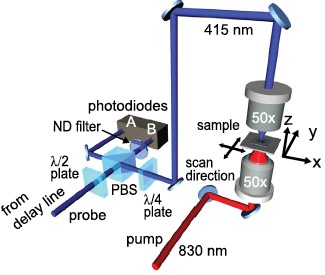Ultra-high-res nondestructive 3-D imaging of biological cells with picosecond ultrasound
April 20, 2015

Fluorescence micrographs of fat and endothelial cells superimposed on differential-interference and phase-contrast images, respectively. The nuclei are stained blue in the micrographs. The image on the right is a picosecond ultrasonic image of a single endothelial cell with approximately 1-micrometer lateral and 150-nanometer (.15 micrometer) depth resolutions. Deep blue corresponds to the lowest ultrasonic amplitude. (credit: O.Wright/Hokkaido University)
A team of researchers in Japan and Thailand reports the first known nondestructive 3-D scan of a single biological cell using a revised form of “picosecond* ultrasound.”
This new technique can achieve micrometer (millionth of a meter) resolution of live single cells, imaging their interiors in slices separated by 150 nanometers (.15 micrometer), in contrast to the typical 0.5-millimeter (500 micrometers) spatial resolution of a standard medical MRI scan.
The work is a proof-of-principle that could open the door to new ways of studying the physical properties of living cells by imaging them non-destructively in vivo, the researchers say.
Achieving ultra-high resolution of live cells

Experimental setup of picosecond ultrasonics sytstem. PBS: polarization beam splitter. ND filter: neutral density filter. (credit: Sorasak Danworaphong et al./Applied Physics Letters)
The team accomplished the imaging by first placing a cell in solution on a titanium-coated sapphire substrate and then scanning with a point source of high-frequency sound generated by using a beam of focused ultrashort laser pulses over the titanium film. This was followed by focusing another beam of laser pulses on the same point to pick up tiny changes in optical reflectance caused by the sound traveling through the cell tissue.
“By scanning both beams together, we’re able to build up an acoustic image of the cell that represents one slice of it,” explained co-author Professor Oliver B. Wright, who teaches in the Division of Applied Physics, Faculty of Engineering at Hokkaido University. “We can view a selected slice of the cell at a given depth by changing the timing between the two beams of laser pulses.”
“The time required for 3-D imaging [with conventional acoustic microscopes] probably remains too long to be practical,” Wright said. “Building up a 3-D acoustic image, in principle, allows you to see the 3-D relative positions of cell organelles without killing the cell.
“By using an ultraviolet-pulsed laser, we could improve the lateral resolution by about a factor of three — and greatly improve the image quality. And, switching to a diamond substrate instead of sapphire would allow better heat conduction away from the probed area, which, in turn, would enable us to increase the laser power and image quality.”
The paper is the cover story today in the journal Applied Physics Letters today (April 20).
Authors of this study are affiliated with Walailak University and Hokkaido University.
* A picosecond is a trillionth of second, or 10−12 second. Picosecond ultrasonics has been used for decades as a method to explore the mechanical and thermal properties of materials like metals and semiconductors at submicron scales, and in recent years it has been applied to biological systems as well. The technique is suited for biology because it’s sensitive to sound velocity, density, acoustic impedance and the bulk modulus of cells. The new technique extends the resoluton of this technique.
Their work centers on imaging two types of mammalian biological tissue — a bovine aortic endothelial cell, a type of cell that lines a cow’s main artery blood vessel, and a mouse “adipose” fat cell.
Endothelial cells were chosen because they play a key role in the physiology of blood cells and are useful in the study of biomechanics. Fat cells were also studied to provide an interesting comparison with varying cell geometries and contents.
Abstract of Three-dimensional imaging of biological cells with picosecond ultrasonics
We use picosecond ultrasonics to image animal cells in vitro—a bovine aortic endothelial cell and a mouse adipose cell—fixed to Ti-coated sapphire. Tightly focused ultrashort laser pulses generate and detect GHz acoustic pulses, allowing three-dimensional imaging (x, y, and t) of the ultrasonic propagation in the cells with ~1 µm lateral spatial resolution. Time-frequency representations of the continuous-wavelet-transform amplitude of the optical reflectivity variations inside and outside the cells show GHz Brillouin oscillations, allowing the average sound velocities of the cells and their ultrasonic attenuation to be obtained as well as the average bulk moduli.